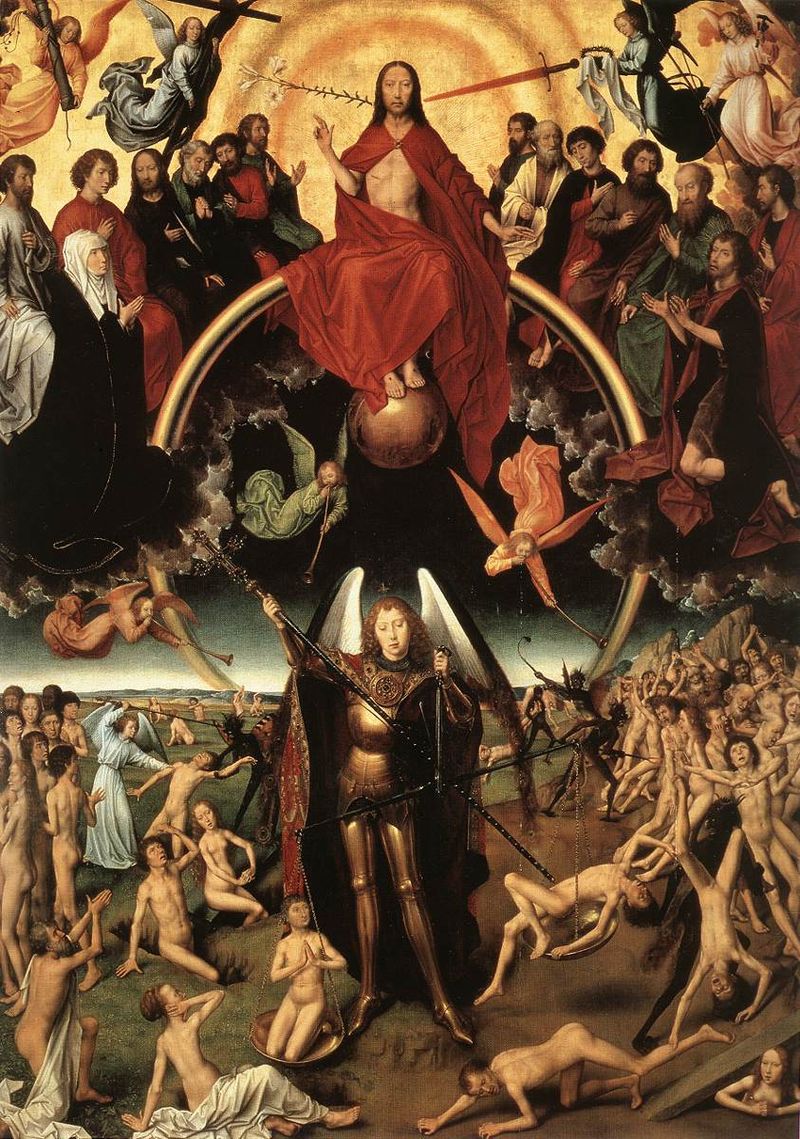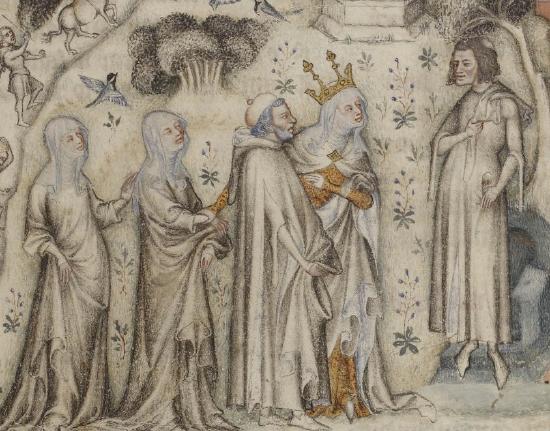11.2: Vocal Music in the Medieval Ages
- Page ID
- 169117
\( \newcommand{\vecs}[1]{\overset { \scriptstyle \rightharpoonup} {\mathbf{#1}} } \)
\( \newcommand{\vecd}[1]{\overset{-\!-\!\rightharpoonup}{\vphantom{a}\smash {#1}}} \)
\( \newcommand{\id}{\mathrm{id}}\) \( \newcommand{\Span}{\mathrm{span}}\)
( \newcommand{\kernel}{\mathrm{null}\,}\) \( \newcommand{\range}{\mathrm{range}\,}\)
\( \newcommand{\RealPart}{\mathrm{Re}}\) \( \newcommand{\ImaginaryPart}{\mathrm{Im}}\)
\( \newcommand{\Argument}{\mathrm{Arg}}\) \( \newcommand{\norm}[1]{\| #1 \|}\)
\( \newcommand{\inner}[2]{\langle #1, #2 \rangle}\)
\( \newcommand{\Span}{\mathrm{span}}\)
\( \newcommand{\id}{\mathrm{id}}\)
\( \newcommand{\Span}{\mathrm{span}}\)
\( \newcommand{\kernel}{\mathrm{null}\,}\)
\( \newcommand{\range}{\mathrm{range}\,}\)
\( \newcommand{\RealPart}{\mathrm{Re}}\)
\( \newcommand{\ImaginaryPart}{\mathrm{Im}}\)
\( \newcommand{\Argument}{\mathrm{Arg}}\)
\( \newcommand{\norm}[1]{\| #1 \|}\)
\( \newcommand{\inner}[2]{\langle #1, #2 \rangle}\)
\( \newcommand{\Span}{\mathrm{span}}\) \( \newcommand{\AA}{\unicode[.8,0]{x212B}}\)
\( \newcommand{\vectorA}[1]{\vec{#1}} % arrow\)
\( \newcommand{\vectorAt}[1]{\vec{\text{#1}}} % arrow\)
\( \newcommand{\vectorB}[1]{\overset { \scriptstyle \rightharpoonup} {\mathbf{#1}} } \)
\( \newcommand{\vectorC}[1]{\textbf{#1}} \)
\( \newcommand{\vectorD}[1]{\overrightarrow{#1}} \)
\( \newcommand{\vectorDt}[1]{\overrightarrow{\text{#1}}} \)
\( \newcommand{\vectE}[1]{\overset{-\!-\!\rightharpoonup}{\vphantom{a}\smash{\mathbf {#1}}}} \)
\( \newcommand{\vecs}[1]{\overset { \scriptstyle \rightharpoonup} {\mathbf{#1}} } \)
\( \newcommand{\vecd}[1]{\overset{-\!-\!\rightharpoonup}{\vphantom{a}\smash {#1}}} \)
\(\newcommand{\avec}{\mathbf a}\) \(\newcommand{\bvec}{\mathbf b}\) \(\newcommand{\cvec}{\mathbf c}\) \(\newcommand{\dvec}{\mathbf d}\) \(\newcommand{\dtil}{\widetilde{\mathbf d}}\) \(\newcommand{\evec}{\mathbf e}\) \(\newcommand{\fvec}{\mathbf f}\) \(\newcommand{\nvec}{\mathbf n}\) \(\newcommand{\pvec}{\mathbf p}\) \(\newcommand{\qvec}{\mathbf q}\) \(\newcommand{\svec}{\mathbf s}\) \(\newcommand{\tvec}{\mathbf t}\) \(\newcommand{\uvec}{\mathbf u}\) \(\newcommand{\vvec}{\mathbf v}\) \(\newcommand{\wvec}{\mathbf w}\) \(\newcommand{\xvec}{\mathbf x}\) \(\newcommand{\yvec}{\mathbf y}\) \(\newcommand{\zvec}{\mathbf z}\) \(\newcommand{\rvec}{\mathbf r}\) \(\newcommand{\mvec}{\mathbf m}\) \(\newcommand{\zerovec}{\mathbf 0}\) \(\newcommand{\onevec}{\mathbf 1}\) \(\newcommand{\real}{\mathbb R}\) \(\newcommand{\twovec}[2]{\left[\begin{array}{r}#1 \\ #2 \end{array}\right]}\) \(\newcommand{\ctwovec}[2]{\left[\begin{array}{c}#1 \\ #2 \end{array}\right]}\) \(\newcommand{\threevec}[3]{\left[\begin{array}{r}#1 \\ #2 \\ #3 \end{array}\right]}\) \(\newcommand{\cthreevec}[3]{\left[\begin{array}{c}#1 \\ #2 \\ #3 \end{array}\right]}\) \(\newcommand{\fourvec}[4]{\left[\begin{array}{r}#1 \\ #2 \\ #3 \\ #4 \end{array}\right]}\) \(\newcommand{\cfourvec}[4]{\left[\begin{array}{c}#1 \\ #2 \\ #3 \\ #4 \end{array}\right]}\) \(\newcommand{\fivevec}[5]{\left[\begin{array}{r}#1 \\ #2 \\ #3 \\ #4 \\ #5 \\ \end{array}\right]}\) \(\newcommand{\cfivevec}[5]{\left[\begin{array}{c}#1 \\ #2 \\ #3 \\ #4 \\ #5 \\ \end{array}\right]}\) \(\newcommand{\mattwo}[4]{\left[\begin{array}{rr}#1 \amp #2 \\ #3 \amp #4 \\ \end{array}\right]}\) \(\newcommand{\laspan}[1]{\text{Span}\{#1\}}\) \(\newcommand{\bcal}{\cal B}\) \(\newcommand{\ccal}{\cal C}\) \(\newcommand{\scal}{\cal S}\) \(\newcommand{\wcal}{\cal W}\) \(\newcommand{\ecal}{\cal E}\) \(\newcommand{\coords}[2]{\left\{#1\right\}_{#2}}\) \(\newcommand{\gray}[1]{\color{gray}{#1}}\) \(\newcommand{\lgray}[1]{\color{lightgray}{#1}}\) \(\newcommand{\rank}{\operatorname{rank}}\) \(\newcommand{\row}{\text{Row}}\) \(\newcommand{\col}{\text{Col}}\) \(\renewcommand{\row}{\text{Row}}\) \(\newcommand{\nul}{\text{Nul}}\) \(\newcommand{\var}{\text{Var}}\) \(\newcommand{\corr}{\text{corr}}\) \(\newcommand{\len}[1]{\left|#1\right|}\) \(\newcommand{\bbar}{\overline{\bvec}}\) \(\newcommand{\bhat}{\widehat{\bvec}}\) \(\newcommand{\bperp}{\bvec^\perp}\) \(\newcommand{\xhat}{\widehat{\xvec}}\) \(\newcommand{\vhat}{\widehat{\vvec}}\) \(\newcommand{\uhat}{\widehat{\uvec}}\) \(\newcommand{\what}{\widehat{\wvec}}\) \(\newcommand{\Sighat}{\widehat{\Sigma}}\) \(\newcommand{\lt}{<}\) \(\newcommand{\gt}{>}\) \(\newcommand{\amp}{&}\) \(\definecolor{fillinmathshade}{gray}{0.9}\)Vocal Music in the Medieval Era (476-1400)
The Medieval Period covers the time in Western Europe from the Fall of the Roman Empire (476 AD) to about 1400 AD. Following the Fall of the Roman Empire, the Catholic Church gained significant power over both religion and politics over all of Europe. Because of its huge influence, much of the music that survives to this day from this time period is sacred music. This is not to say that all music written during this period was religious, but because the Catholic Church had so much money and resources, they were able to pay for scribes to write down their music, which is why so much if it has survived to the modern day.
Common genres of music in the Medieval Era are chant, the Catholic mass, and secular song.
Read through this unit, and when you're done, watch the video presentation, which will provide more clarity on some of the more difficult concepts.
Catholic Chant.
The Catholic church services followed the religious traditions of prior times, and included chant. Chant is unaccompanied liturgical song used in religious services; throughout all of the Medieval Era, everything done during a Catholic mass (the religious ceremony) was sung in chant-style. This eventually became known as plainchant, or Gregorian Chant (named after Pope Gregory II who codified the structure of the Catholic mass during the 8th century AD).
Chant is monophonic (a single melodic line with no accompaniment), sacred (sung in religious services), and is melisamatic—that is, it contains many melismata (the plural of melisma). Melismata occur when you sing a single syllable of text on many long-held notes. Listen to this "Alleluia" and you'll hear the word sung over about 20 seconds of "ahhhhh"—this is a single melisma, and is a defining characteristic of chant. As you listen, try to keep a steady beat, and you'll notice that you're unable to keep one! This is another defining characteristic of the chant -- they are completely rhythmically free. The chant is part of the prayer and dialogue between the priest and the congregation; the music is just as important as the words to which they are attached.
In the Medieval era, even up until the 1960s, the entire mass during the Catholic service was chanted. This video shows a historical re-enactment of a Catholic Mass. Notice how everything is chanted by either the Priest or the rest of the congregation.
You'll likely notice that there is great reverberation in the sound -- remember that these chants were traditionally sung in large cathedrals, which create a very live and vibrant sound.
Dies Irae: The Catholic Hymn.
 Within the church service, the congregation and the priest would often sing a hymn together. This is a tradition that continues to this day, and predates that Catholic church. A hymn is a religious song of praise to God, and is very different when compared to the chant. They are rhythmically much more stable; you'll be able to keep a beat very easily. They are often written in a strophic (or verse) form. There is often a rhyme-scheme to them like modern songs.
Within the church service, the congregation and the priest would often sing a hymn together. This is a tradition that continues to this day, and predates that Catholic church. A hymn is a religious song of praise to God, and is very different when compared to the chant. They are rhythmically much more stable; you'll be able to keep a beat very easily. They are often written in a strophic (or verse) form. There is often a rhyme-scheme to them like modern songs.
Dies Irae is a Medieval-Era poem about the Day of Wrath, or the Day of Judgement, which depicts the time where God comes down to Earth to judge all of creation. The image to the left is a famous depiction of this day: a painting attbributed to Flemish painter Hans Memling.
The hymn Dies Irae is one of the most famous and melodies in the Western canon, and was composed around the 13th century AD, likely by some Benedictine Monk employed by the church. Like much of the music that was written for the church, we do not know who composed it, because the monks who wrote the music did not sign their names to the music (they were not seeking fame for their work). The text for the poem is provided below (taken from the Wikipedia page). The original Latin text is on the left, and as you can see, it follows a specific rhyme scheme as one would expect to hear in a song. The "Approved adaptation" is an English translation that tries to keep the same amount of syllables per line, while maintaining the rhyme scheme. The "Fomal Equivalence" is a more literal translation, but as you can see, it doesn't conform to any specific rhythm or rhythm.
Take a listen to this famous hymn, and follow along with the text provided below and follow along with the "Original" text on the left side of the column. Though it is sung by a choir, notice that they are all singing the same exact melody -- this is a monophonic texture -- a single melody with no accompaniment. When you're done, view the video presentation for this piece for more discussion on this famous melody.
"Day of Judgement," by Hans Memling. Public Domain.

Text of "Dies Irae." (left): original Latin; (middle): adaptation; (right): literal translation. Screenshot taken from Wikipedia.
Medieval Polyphony: Guillaume de Machaut and the Secular Song.

Picture of a Parisian manuscript from the 1350s depicting Machaut (right). Public Domain
Over time, composers and monks who wrote music in the church began to experiment with playing multiple notes at the same time in an independent manner. You may be thinking to yourself "why are we spending so much time looking at early Catholic music?" The answer is because modern harmony and polyphony developed within the Catholic church. Up until around 900 AD, music was mostly monophonic. If instruments accompanied a singer, it often would play the same melody that the singer would sing, or provide some single "drone" note. But again, most music in the Medieval Period was purely sung.
Around 900 AD, composers within the Catholic church (mostly monks and other religious people working for the church) began experimenting with combining independent lines and layers of music. This developed into a polyphonic texture. Both Sacred and Secular music embraced this style: combining multiple independent melodies at once. In some instances, composers would combine 3, 4, 5, or more independent melodies at the same time.
Keep in mind, that this is very difficult to do. Not only do the melodies need to sound good on their own, but they need to sound good when they're played together!
Composer Guillaume de Machaut (~1300-~1377) was a French poet and composer, who wrote both sacred and secular music. He was the first composer to ever set the Catholic Mass -- the part of the service that celebrates Communion and the Eucharist that was always chanted in a monophonic setting --- to a polyphonic setting. This was incredibly important in the development of Western polyphony and the development of the musical settings of the Catholic mass.
Take a listen to this recording of "Je puis trop bien ma dame comparer," which translates to "I can all too well compare my lady..." You'll notice that there are multiple melodic lines happening at the same time, which all line up to create harmony. This polypohonic texture is something that Machaut was well-known for. In this song, he compares his love of a woman to the the Greek myth of Pygmalion, who as legend had it, sculpted a statue and loved it so deeply, that the goddess Aphrodite took pity on him and turned the statue into a real person. When you're done listening to this, watch the video presentation on this piece for a more thorough discussion of how to listen to the independent melodies within this piece.

